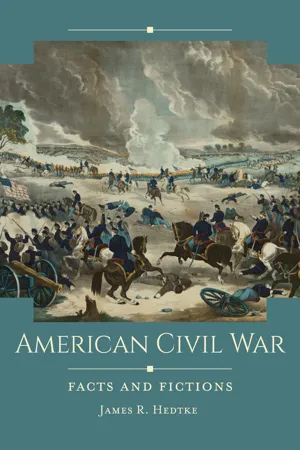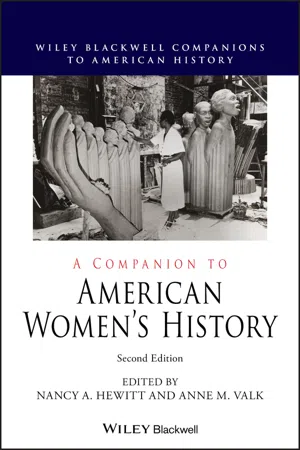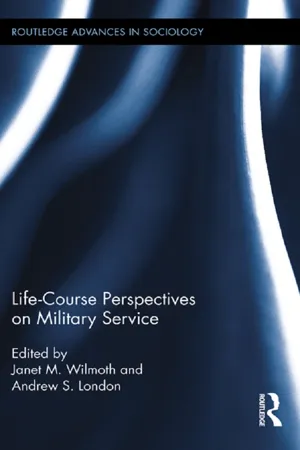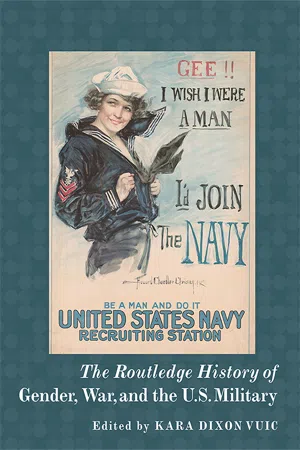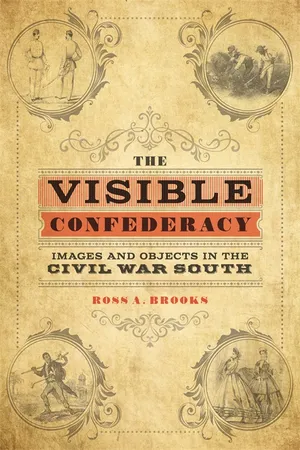History
Women Soldiers in the Civil War
During the Civil War, some women disguised themselves as men to fight in the conflict. They served in both the Union and Confederate armies, taking on various roles such as soldiers, spies, and nurses. Their contributions challenged traditional gender roles and expanded the perception of women's capabilities in wartime.
Written by Perlego with AI-assistance
Related key terms
7 Key excerpts on "Women Soldiers in the Civil War"
- eBook - ePub
American Civil War
Facts and Fictions
- James R. Hedtke(Author)
- 2018(Publication Date)
- ABC-CLIO(Publisher)
My Story of the War, Livermore wrote, “Someone has stated that the number of women soldiers known to service as little less than four hundred.” She then stated that she believed the number was probably higher than that figure. Historians have used Livermore’s estimate of 400 women as a benchmark in their research and publications. The number of female soldiers may have been higher or lower, but there is no doubt that women of both sides fought for their respective militaries.Women joined the armed services during the Civil War for adventure, patriotism, financial remuneration, vengeance, to stay with a loved one, and to escape the strict social conventions for women in the Victorian age. They were able to enter the service because medical exams were pro forma and rarely involved a thorough physical examination. Women were able to maintain their disguise through loose-fitting male attire, the youthful appearance of many recruits, and mid-19th-century societal standards of modesty. Males were also reluctant to believe that women could function as competent soldiers. Authorities discovered women soldiers when they were hospitalized for disease or wounds, captured, became pregnant, or were killed.Newspaper reports provided the first evidence of women soldiers in the ranks of both armies. Writers found the women interesting not because of their significant contribution to the war effort but for their presence in the military in defiance of societal norms. Female soldiers made good copy because they broke the stereotype of the midcentury woman as demur, passive, and obedient. The Richmond Examiner, The Chicago Tribune, and The New York Times published stories about female soldiers in which they praised the patriotism and extolled the free spirit of these women. One example is The Richmond Examiner’s coverage in the fall of 1864 of two Virginia cousins, Mary and Molly Bell. The pair had served in the Confederate army for two years and fought in several battles, including Chancellorsville and Gettysburg. In October 1864, Confederate officials found out their identity and imprisoned them at Castle Thunder in Richmond. They were released from prison in late November 1864 and sent home to their parents. The Richmond Examiner - eBook - ePub
- Nancy A. Hewitt, Anne M. Valk(Authors)
- 2020(Publication Date)
- Wiley-Blackwell(Publisher)
Some have focused on the exceptional women who donned Confederate or Federal uniforms. DeAnne Blanton and Lauren Cook (2002), Richard Hall (2006), and Karen Abbott (2014), for example, have all explored the motivations, experiences, bodily risks, and consequences for those who chose to take up arms. Focusing on more well‐documented examples, they raise questions regarding the number of women who served, their racial demographics, and the diverse reactions of communities that privileged military service as the ultimate expression of manhood. Yet, almost all of the women they discuss are white. Given the martial and masculine rhetoric of Frederick Douglass, Sojourner Truth, and other black recruiters, black women soldiers deserve equal attention. We know that many, like their white counterparts, accompanied their men to battle – especially those who enlisted by reaching Union army camps within the Confederacy. Did they face similar challenges from their families, communities, and fellow soldiers? Far more women from every race, class, and region performed other critical services for Union and Confederate armies. Harriet Tubman has received much scholarly attention for her role as a scout, nurse, and cook and for her participation in the Combahee River Raid (Clinton 2004 ; Larson 2004 ; Lowry 2017). Some women gathered intelligence as spies. Others provided medical care as both nurses and doctors. Many served as laundresses and cooks, including the numerous camp followers who provided critical services to husbands, sons, and brothers (Forbes 1998 ; Hall 2006 ; Hilde 2012). Their motivations were complex. Familial considerations – specifically, whether or not the family could survive with male relatives serving in the armed forces – were central in many cases. Race, class, and ethnic identity had a major influence as well. Some women developed new strategies at home; others headed to the battlefront (Hall 2006 ; Giesberg 2012 ; Mendez 2019) - eBook - ePub
- Janet M. Wilmoth, Andrew S. London(Authors)
- 2013(Publication Date)
- Routledge(Publisher)
This chapter will focus on the impact of two different wars on women’s lives, situating women’s experiences within the broader historical events influencing their families and communities. In much of America during the 19th century, especially in the rural South, the life course of women was deeply embedded in traditional family life. This was so even during wartime, although women were often called upon to take on new roles and perform nontraditional tasks to support themselves and their families. Thus, when considering women in wartime, historians often take what might be considered a “linked lives” approach and focus on women’s roles in their families and how their lives changed as a consequence of the wartime absences of the men to whom their lives were linked. The women themselves were not in combat, but military service was less of an individual affair than a community effort. Therefore, the close link between the soldiers and the home front during the Civil War meant that men’s wartime service had a greater impact on women during the Civil War than during 20th-century wars. Nevertheless, wars have always affected women’s lives. During World War II, the increased participation of women in formal military roles and war-related industries changed the nature of war’s impact on women’s lives.THE CIVIL WARBetter social organization in the North facilitated much more complex activities by women—as typified by national organizations such as the Sanitary Commission and the United States Christian Commission. In these organizations, women played major roles and learned organizational skills that were applied after the war to charitable endeavors, as well as the prohibition and woman suffrage movements. The war did not significantly alter the life course trajectories of most women in the North, where life continued more or less as normal. The impact of absent men on families was temporary, with scarcely a ripple in terms of the pool of eligible spouses, for example (Mitchell 1995). The large volume of volunteer work undertaken by Northern women seems not to have had permanent effects beyond a few leaders (Attie 1998). The disruption caused by death and severe war wounds was profound for the women affected, but did not alter the system of widowhood, except that the widows received government pensions. - eBook - ePub
Heroines in History
A Thousand Faces
- Katie Pickles(Author)
- 2022(Publication Date)
- Routledge(Publisher)
66What were the motivations for joining the army? James M McPherson suggests that ‘motives ranged from patriotism and love of adventure to a desire to stay with husbands or lovers who enlisted.’67 Lauren Cook Burgess suggests that money was a motivation for women cross-dressing enlistees and a way for them ‘to gain a measure of economic, legal, and social independence unavailable to them as women.’68 For the three most famous cross-dressing heroines of the American Civil War, Bonnie Tsui argues that Emma Edmonds, Sarah Rosetta Wakeman and Loreta Janeta Velázquez ‘all boldly fled from dissatisfying family lives.’ More generally, she argues that in common with the typical male volunteer, the women soldiers were often young, poor and rural.69 Enlisting was a way of earning money and improving their lives.In 1864 when Emma Edmonds wrote a memoir about her recent participation in the American Civil War she failed to mention that she had cross-dressed as a man during her military service.70 In 1867 she married and had three children who all died young, after which she and her husband Linus H Seelye adopted two sons. It was not until she needed to apply for a pension in 1886 that she disclosed more about her wartime activities. Edmonds succeeded in receiving a government pension of $12 a month for her military service and having a desertion charge dropped. She went on to lecture on her life story and in 1897 became the sole woman admitted to the Grand Army of the Republic (GAR), the Civil War Union Army’s veterans’ association. As further signs of her acceptance, she was buried in the GAR area of the Washington Cemetery in Houston and received full military honours in a second funeral in 1901. In 1992 she was inducted into the Michigan Women’s Hall of Fame.71 - eBook - ePub
Female Soldiers in Sierra Leone
Sex, Security, and Post-Conflict Development
- Megan H. MacKenzie(Author)
- 2012(Publication Date)
- NYU Press(Publisher)
In addition to combat roles, many women and girls performed what has been classified by some as “support roles.” These often include cooking, carrying war booty, food, or ammunition, spying, and taking care of the sick or children. The majority of women and girls also reported that they worked as sex slaves for either a particular commander or portions of their military unit. It should be noted that both males and females performed these support roles; however, the emphasis on distinguishing between combatants and supporters has focused primarily on female soldiers—few organizations or policy makers have spent time debating whether male soldiers were “real” soldiers or just acting in support roles. Policy makers and academics alike seem fixated on whether women and girls used weapons and were involved in active combat. Other forms of labor and activities contributing to the war effort are classified as “support roles” and distinguished from soldiering.The logical maneuvering that categorizes females out of the rank of soldier goes something like this: most females acted in support roles for the fighting forces rather than in combat roles. Therefore females were primarily noncombatants—and, noncombatants are not soldiers. This logic is fallacious both because of the problematic assumption that women and girls were not combatants and because it implies that the support work carried out by females during conflict does not render them soldiers. Vivi Stavrou summarizes the implications of not recognizing various types of labor during the conflict:Not labeling the work of non-combatant women soldiers as soldiering, continues the gender discrimination of the division of labor whereby critical work that is essential for survival, is simply considered a natural extension of women’s domestic obligations and hence neither worthy of remuneration nor significant enough for women to qualify for training and livelihoods programs.28Even though the term “soldier” refers to anyone who is a member of an armed group, questions and concerns over the distinction between “combatant” and “soldier” have been raised in relation to women and girls. A review of the capacities, ranks, and services of any army reveals that a variety of duties and contributions are required for almost all combat operations; however, typically there are few who question whether male officers who fulfill support roles such as medical operations or communications are “real soldiers.” When men act as porters, cleaners, domestic help, or messengers during war, there is little debate about the extent to which they deserve the soldier title. However, there has been extensive debate about the functions of female soldiers in Sierra Leone and the extent to which their work “counts” as soldiering. While great effort was made by post-conflict policy makers to name women and girls something other than soldiers, “men involved with the military in support functions are defined as soldiers, and not as ‘men involved in armed groups or forces,’ or as men directly associated with the war;’ or as dependants of male or female combatants.”29 - Kara Vuic, Kara D. Vuic(Authors)
- 2017(Publication Date)
- Routledge(Publisher)
All the Daring of the Soldier: Women of the Civil War Armies (New York: Penguin Books, 1999).15 Stephen Berry, All That Makes a Man: Love and Ambition in the Civil War South (New York: Oxford University Press, 2003): 9; Reid Mitchell, “Soldiering, Manhood, and Coming of Age: A Northern Volunteer,” in Clinton and Silber, eds. Divided Houses : 44–46.16 On competing conceptions of manhood, see Lorien Foote, The Gentlemen and the Roughs: Manhood, Honor, and Violence in the Union Army (New York: New York University Press, 2010). On courage and its cultivation during the Civil War, see Gerald F. Linderman, Embattled Courage: The Experience of Combat in the American Civil War (New York: Free Press, 1987). On disillusionment and disability, see among others, Blight, “No Desperate Hero”; Eric T. Dean, Jr., Shook Over Hell: Post-Traumatic Stress, Vietnam, and the Civil War (Cambridge: Harvard University Press, 1997); Diane Miller Sommerville, “‘A Burden Too Heavy to Bear’: War Trauma, Suicide, and Confederate Soldiers,” Civil War History 59, no. 4 (Dec. 2013): 453–91; Lesley J. Gordon, A Broken Regiment: The Sixteenth Connecticut’s Civil War (Baton Rouge: Louisiana State University Press, 2014); Brian Craig Miller, Empty Sleeves: Amputation in the Civil War South (Athens: University of Georgia Press, 2015); Sarah Handley-Cousins, “‘Wrestling at the Gates of Death’: Joshua Lawrence Chamberlain and Nonvisible Disability in the Post-Civil War North,” Journal of the Civil War Era 6, no. 2 (June 2016): 220–42.17 Frederick Douglass, “Should the Negro Enlist in the Union Army?,” Douglass’s Monthly (Aug. 1863).18 Stephen Kantrowitz, “Fighting Like Men: Civil War Dilemmas of Abolitionist Manhood,” in Catharine Clinton and Nina Silber, eds. Battle Scars : Gender and Sexuality in the American Civil War (New York: Oxford University Press, 2006): 19. See also Carole Emberton, “‘Only Murder Makes Men’: Reconsidering the Black Military Experience,” Journal of the Civil War Era- eBook - ePub
The Visible Confederacy
Images and Objects in the Civil War South
- Ross A. Brooks(Author)
- 2019(Publication Date)
- LSU Press(Publisher)
CHAPTER 8Representations of WomanhoodMRS. DELAFIELD : Ah! Olivia, what can weak woman do to aid in repelling the myriads which our foes are marshalling against us.MRS. WALTON : Do, mother! Much, if nerved by a proper spirit. They can toil and endure; do as we are doing, spin, weave and knit, that their brave defenders may be provided against the winter’s frost and the summer’s sun. They can teach their infants that “resistance to tyrants is obedience to God!” And imbue their tender minds with an unquenchable hatred of the Puritan race, that would enslave their fathers and their mothers.—J. J. DELCHAMPS , Love’s Ambuscade; or, The Sergeant’s Stratagem, 1863T he Civil War disrupted and transformed Southern women’s lives.1 State and central governments demanded more of their families and resources, inflation weakened the buying power of their money, and the conflict disrupted the social order. It also stimulated greater visibility for women.2 “Patriotic expectations” led women out of their homes to contribute to the war effort and gave them a physical presence in the army and in city life.3 Early in the war, they volunteered their services to make clothing. Later large townships such as Richmond saw “battalions” of women carrying “bundles of soldier’s apparel” to and from the quartermaster’s clothing depots as piecework.4 Women featured prominently in concerts and plays on the Confederate stage. At the same time, some developed a new collective political identity and even worked to oppose the Confederacy.5 Depictions of women in illustrated journals captured Confederate men’s responses to their labors.6 Collectively, these works helped make manifest women’s presence in the Confederate States.Male artists usually pictured women and their lives in the Civil War South.7 However, nineteenth-century men were not well placed to do so. They distanced themselves from real women and treated them as abstractions.8
Index pages curate the most relevant extracts from our library of academic textbooks. They’ve been created using an in-house natural language model (NLM), each adding context and meaning to key research topics.
